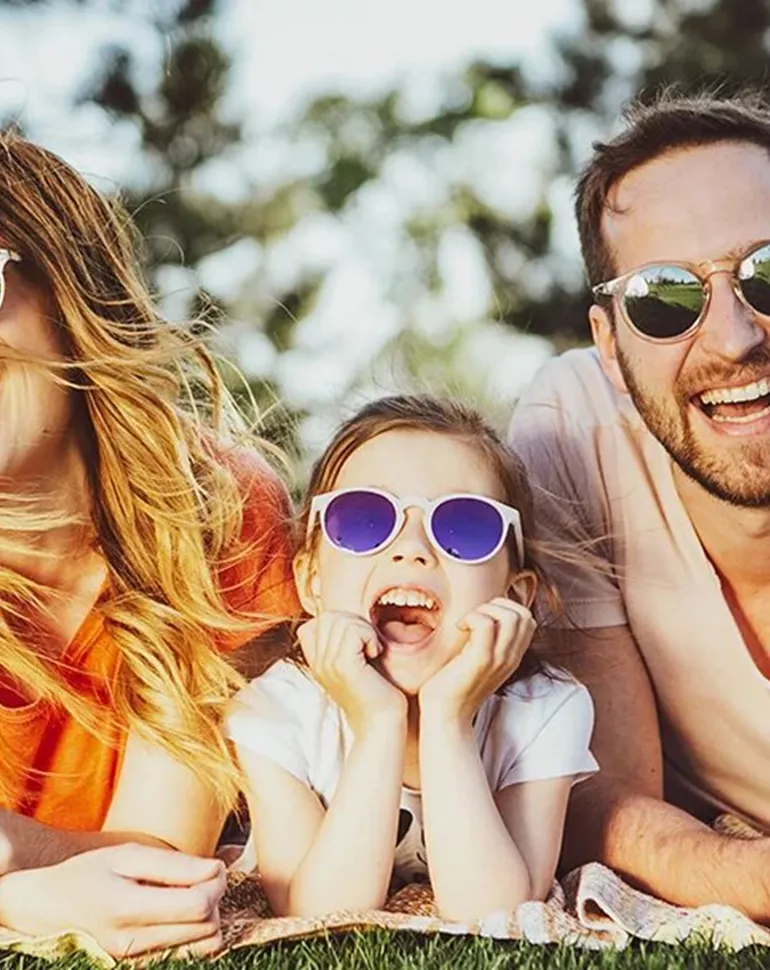Protecting your eyes against UV and HEV (high-energy visible) blue light is important for all ages. It’s vital that you protect not just your eyes, but the areas around them from damaging UV light. Working with your eye doctor to find the right materials, lenses, and coatings for your indoor pair and sunglasses makes a big difference.
Understanding UV and Blue Light
The majority of UV and blue light we are exposed to comes from outside. It’s very important you have the right tools to protect you from the sun’s warm, yet damaging rays. Before we explore how to protect your eyes, it’s a good idea to know a little bit about what you are protecting them from.
UV (ultraviolet) light damages the outside of your eyes and the surrounding skin. The area around your eyes is often exposed and difficult to protect with items like sunscreen. This is why sunglasses generally use larger frames than regular glasses. Too much UV exposure can cause skin cancer and lead to cataracts in your eyes.
Solar blue light, on the other hand, damages the interior of your eyes. Long term exposure increases the chance of developing certain eye maladies such as age-related macular degeneration. Children are at a much higher risk of this damage as their eyes let in much more light than an adult.
You can help protect your eyes by staying in the shade, wearing a hat, and being aware of when and how long you are exposed to either blue light or UV light. However, sunglasses are still the best form of protection when they offer the right protection.
Choosing the Right Materials and Coatings
Protecting your eyes isn’t the sole responsibility of your sunglasses, even if they do the heavy lifting. Your primary pair of indoor glasses might offer some UV protection as well.
Even if we still call them glasses, we’ve sunsetted that material for lighter, more advanced ones. Trivex and polycarbonate are two types of material commonly used today. Both offer complete UV protection.
Your sunglasses should block 100% UV light and a significant portion of blue light. Specialized coatings on sunglasses and glasses can help protect you from glare, reflection, and even blue light caused by the sun.
How to Choose the Right Materials for You
The best and only way we recommend choosing the right materials is to consult with your eye doctor. There are many options, and your eye care professional will work with you based on your prescription, lifestyle, and vision needs to recommend the right materials, coatings, and even frames.
It might seem daunting knowing what to ask, though, so here are a few questions you can use to start the conversation on protecting your eyes from the sun.
- What material are my lenses made out of? What protection does it offer?
- Regarding kids: How important is it for children to wear UV protection?
- Am I getting protection from my regular glasses? Or contact lenses?
- Ask about your current pair of sunglasses.
- Ask them about photochromics and why they might be a good fit for you and your kids.
Don’t have a regular eye doctor? We can help you find one.
A Note on Light Reactive Protection
Especially for children, adherence to wearing sunglasses outside every time can be difficult. Light reactive lenses, sometimes called photochromics, helps you stay protected in and out of the sun.
Light reactive lenses like our Sensity line or Transitions 8 lenses change as you go from inside to outside, and back again.
Making Sunglasses a Habit
The most challenging part of protecting your eyes is adhering to it. This goes for adults and children. The best thing you can do is make wearing sunglasses part of your routine, so it becomes a habit.
Building habits takes time and effort, and you probably won’t go from forgetting sunglasses to wearing them at the right time every day. Start small and create reminders. Set your sunglasses next to your keys, or the other way around. When packing your child’s lunch, make sunglasses part of your final checklist before packing their backpack.
If you are developing habits with your children, mirror them in yourself. You can help teach them through example, which makes it easier to hold them accountable for wearing their sunglasses every day, too.
When you are ready to make protecting your eyes a habit, go see your eye doctor to find out what type of protection is best for you.
